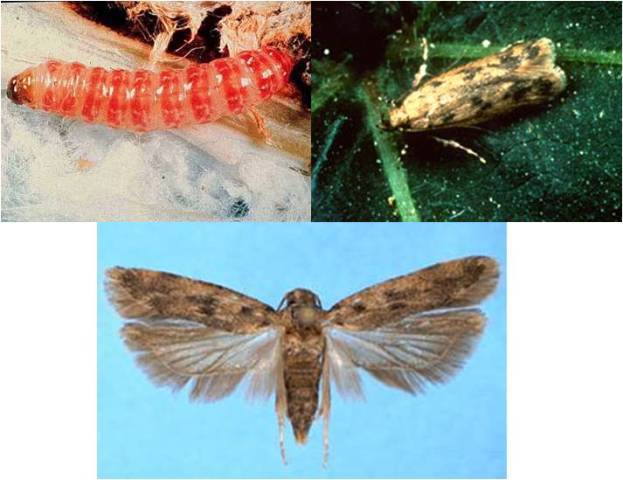
Pink bollworm (Pectinophora gossypiella; Spanish: lagarta rosada) is an insect known for being a pest in cotton farming. The adult is a small, thin, gray moth with fringed wings. The larva is a dull white caterpillar with eight pairs of legs with conspicuous pink banding along its dorsum. The larva reaches one-half inch in length.
The pink bollworm is native to Asia but has become an invasive species in most of the world's cotton-growing regions. It reached the cotton belt in the southern United States by the 1920s.
The pest is a major pest of cotton in southern California deserts. While apparently established in the San Joaquin Valley, economic infestations have not occurred in this area. Adults are small, grayish brown, inconspicuous moths. When their wings are folded, they have an elongated slender appearance. The wing tips are conspicuously fringed. Young larvae are tiny, white caterpillars with dark brown heads. When mature, they are about 0.5 inches long and have wide transverse pink bands on the back. To be able to see pink bollworm larvae, bolls have to be cracked open. The first and second instars are difficult to see against the white lint of the bolls. Eggs are very small, slightly elongated, and laid under the calyx of green bolls.
The female moth lays eggs in a cotton boll and when the larvae emerge from the eggs, they inflict damage through feeding. They chew through the cotton lint to feed on the seeds. Since cotton is used for fiber and seed oil, the damage is twofold. Their disruption of the protective tissue around the boll is a portal of entry for other insects and fungi.
In parts of India, the pink bollworm is now resistant to first generation transgenic Bt cotton (Bollgard cotton) that expresses a single Bt gene (Cry1Ac). Monsanto has admitted that this variety is ineffective against the pink bollworm pest in parts of Gujarat, India. Infestation on susceptible cotton is generally controlled with insecticides. Once a crop has been harvested, the field is plowed under as soon as possible to stop the life cycle of the new generation of bollworm. Unharvested bolls harbor the larvae, so these are destroyed. The plants are plowed into the earth and the fields are irrigated liberally to drown out remaining pests. Some farmers burn the stubble after harvest. Surviving bollworms will overwinter in the field and re-infest the following season. Populations of bollworms are also controlled with mating disruption, chemicals, and releases of sterile males which mate with the females but fail to fertilize their eggs.

The insect was a serious concern for cotton in India. The fact is that the worm is happily chewing up Bollgard-II-Bt-cotton which contains two genes (cry1Ac+cry2Ab) that were supposed to be highly effective in controlling the pest. Studies conducted by ICAR-CICR (Central Institute for Cotton Research,Nagpur) over the past two years, clearly showed that the pink bollworm developed resistance to two Cry toxins deployed in Bollgard-II.
Damage caused by Pink Bollworm
Pink bollworms damage squares and bolls, the damage to bolls being the most serious. Larvae burrow into bolls, through the lint, to feed on seeds. As the larva burrows within a boll, lint is cut and stained, resulting in severe quality loss. Under dry conditions, yield and quality losses are directly related to the percentage of bolls infested and the numbers of larvae per boll. With high humidity, it only takes one or two larvae to destroy an entire boll because damaged bolls are vulnerable to infection by boll rot fungi.
Management of Pink Bollworm
When high population levels of pink bollworm occur, the objectives of management are to keep infestations below damaging levels in the current season—without creating secondary outbreaks of other pests and to reduce the overwintering population that will threaten the following season's crop. The main control tools are the observance of the host-free period (San Joaquin Valley), the judicious use of insecticides, timely crop termination and harvest, rapid crop destruction, properly timed winter and spring irrigations, and compliance with plow down requirements. When pink bollworms are found in the San Joaquin Valley, a regional monitoring and sterile moth release program is implemented.
Because of the danger of secondary outbreaks, especially in the low desert valleys, it is wise to limit insecticide treatments to those periods when susceptible bolls are present and when sampling shows the percentage of infested bolls is above the treatment threshold. It is rarely necessary to apply insecticides against moths from the overwintered population of pink bollworm and, often, treatments are not needed against the first generation of moths that develop from larvae within squares. Be alert, however, for high populations of pink bollworm moths when squares are developing, especially if other pests such as lygus bugs and armyworms are also threatening. Mating disruptants and sterile moth releases, on the other hand, are most effective when aimed at the overwintering generation usually, about the time cotton plants have 6 to 8 leaves.











